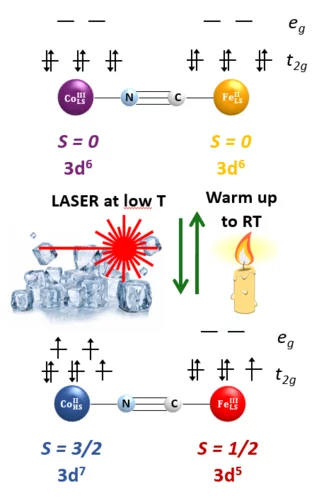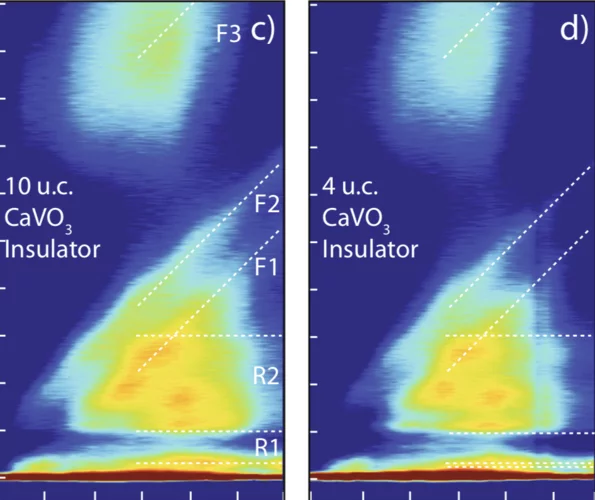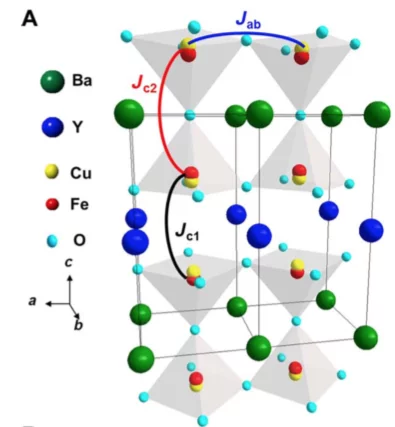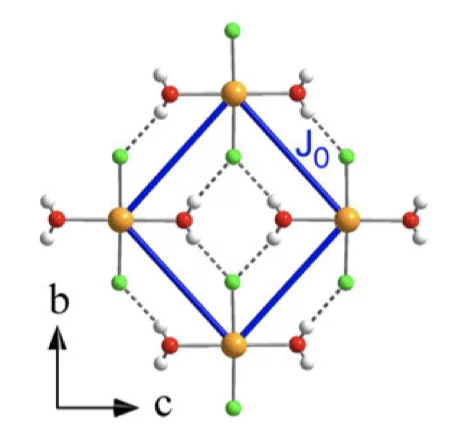Magnetically Addressable Shape-Memory and Stiffening in a Composite Elastomer
With a specific stimulus, shape‐memory materials can assume a temporary shape and subsequently recover their original shape, a functionality that renders them relevant for applications in fields such as biomedicine, aerospace, and wearable electronics. Shape‐memory in polymers and composites is usually achieved by exploiting a thermal transition to program a temporary shape and subsequently recover the original shape.
Chirally coupled nanomagnets
Magnetically coupled nanomagnets have multiple applications in nonvolatile memories, logic gates, and sensors. The most effective couplings have been found to occur between the magnetic layers in a vertical stack. We achieved strong coupling of laterally adjacent nanomagnets using the interfacial Dzyaloshinskii-Moriya interaction. This coupling is mediated by chiral domain walls between out-of-plane and in-plane magnetic regions and dominates the behavior of nanomagnets below a critical size.
Photoswitching in a Molecular Cube
Niéli’s paper is accepted in the Journal of Physical Chemistry Letters! We use X-ray absorption spectroscopy and X-ray magnetic circular dichroism to watch directly how the Co and Fe ions in a molecular cube change their oxidation states and turn from diamagnetic into paramagnetic units upon light irradiation.
New Method for Calculating Soft X-ray Magnetic Circular Dichroism Spectra
Scientists have demonstrated in a combined theoretical and experimental effort that the new ligand-field density functional theory method (LF-DFT) can be used to calculate the X-ray absorption spectra (XAS) and X-ray magnetic circular dichroism (XMCD) of lanthanide compounds from purely structural input.
Electronic localization in CaVO3 films via bandwidth control
Understanding and controlling the electronic structure of thin layers of quantum materials is a crucial first step towards designing heterostructures where new phases and phenomena, including the metal-insulator transition (MIT), emerge. Here, we demonstrate control of the MIT via tuning electronic bandwidth and local site environment through selection of the number of atomic layers deposited.
Design of magnetic spirals in layered perovskites: Extending the stability range far beyond room temperature
In insulating materials with ordered magnetic spiral phases, ferroelectricity can emerge owing to the breaking of in- version symmetry. This property is of both fundamental and practical interest, particularly with a view to exploiting it in low-power electronic devices. Advances toward technological applications have been hindered, however, by the rel- atively low ordering temperatures Tspiral of most magnetic spiral phases, which rarely exceed 100 K.
Observation of the out-of-plane magnetization in a mesoscopic ferromagnetic structure superjacent to a superconductor
The geometry of magnetic flux penetration in a high temperature superconductor at a buried interface was imaged using element-specific x-ray excited luminescence. We performed low tem- perature observation of the flux penetration in YBa2Cu3O7–δ (YBCO) at a buried interface by imaging of the perpendicular magnetization component in square Permalloy (Py) mesostructures patterned superjacent to a YBCO film.
Demonstration of femtosecond X-ray pump X-ray probe diffraction on protein crystals
Our experiments, published in the September issue of Structural Dynamics, demonstrate the feasibility of time-resolved pump-multiprobe X-ray diffraction experiments on protein crystals using a split-and-delay setup which was temporarily installed at the LCLS X-ray Free Electron Laser.
Giant Pressure Dependence and Dimensionality Switching in a Metal-Organic Quantum Antiferromagnet
We report an extraordinary pressure dependence of the magnetic interactions in the metal-organic system [CuF2(H2O)2]2 pyrazine. At zero pressure, this material realizes a quasi-two-dimensional spin-1/2 square-lattice Heisenberg antiferromagnet. By high-pressure, high-field susceptibility measurements we show that the dominant exchange parameter is reduced continuously by a factor of 2 on compression.
Collective magnetism in an artificial 2D XY spin system
Two-dimensional magnetic systems with continuous spin degrees of freedom exhibit a rich spectrum of thermal behaviour due to the strong competition between fluctuations and correlations. When such systems incorporate coupling via the anisotropic dipolar interaction, a discrete symmetry emerges, which can be spontaneously broken leading to a low-temperature ordered phase.
Biologischer Lichtsensor in Aktion gefilmt
Mithilfe eines Röntgenlasers hat ein Team unter Leitung von Forschenden des Paul Scherrer Instituts PSI einen der schnellsten Prozesse in der Biologie aufgezeichnet. Der dabei erzeugte molekulare Film enthüllt, wie der Lichtsensor Retinal in einem Proteinmolekül aktiviert wird. Solche Reaktionen kommen in zahlreichen Organismen vor. Der Film zeigt erstmals, wie ein Protein die Reaktion des eingebetteten Lichtsensors effizient steuert.
Fresnel Zone Plates with Zone Widths below 10 nm
The spot size of a Fresnel Zone Plate lens is mainly determined by the zone widths of its outermost zone. It is therefore essential to fabricate zone plates with structures as small as possible for high-resolution X-ray microscopy. Researchers at the Laboratory for Micro- and Nanotechnology at the PSI have now developed Fresnel zone plates with zone widths well below 10 nm, down to 6.4 nm. These lenses are capable of pushing resolution in X-ray microscopy to the single-digit regime.
Are supersaturated calcium carbonate solutions classical or non-classical ?
Classical theory predicts that supersaturated carbonate solutions consist mostly of ions and ion pairs, with a small number of larger clusters present in the solution. The population of the different sized clusters in a solution is solely defined by the cluster’s size dependent Free Energy. If clusters are large enough they serve as nucleation germs for a new solid phase. The nucleation occurs once the surface free energy barrier posed by the new solid-liquid interface is overcome by the free energy win from bulk phase growth.
Extreme Ultraviolet Vortices at Free Electron Lasers
PSI scientists have developed tailored diffractive X-ray optics for a free electron laser that induces an optical vortex in extreme ultraviolet radiation. The experiment facilitates the first demonstration of orbital angular momentum in radiation created by a free electron laser in the extreme ultraviolet regime, with an extraordinary clean and defined wavefront. In a collaborative effort with researchers from the FERMI free electron laser in Trieste, Italy and from the University of Nova Gorica in Slovenia, the wavefront of the intense beams carrying an orbtial angular momentum was characterized. Furthermore, a method to characterize the footprint of a focused beam from a free electron laser was refined based on ablation imprints in polymers and subsequent treatment with organic solvents. In this way, the sensitivity of the imprint method could be enhanced to a dynamic range of three orders of magnitude in a single shot.
Time- and spatially-resolved magnetization dynamics driven by spin-orbit torques
Current-induced spin-orbit torques hold a great potential for manipulation of magnetization at ultrafast timescales. Researchers at ETH Zürich have demonstrated, using time-resolved STXM imaging at the Swiss Light Source, the influence of spin-orbit torques on the switching behaviour of Pt/Co/AlOx nanostructured elements.
Electromagnon dispersion probed by inelastic X-ray scattering in LiCrO2
Lattice vibrations (phonons) in crystals are typically weakly interacting with the electronic and magnetic degrees of freedom, such as charge and spin fluctuations. Researchers of PSI together with collaborators from EPF Lausanne, Japan and USA discovered an unexpectedly strong coupling between lattice vibrations and spin fluctuations in the quantum magnet LiCrO2. The observed magnetoelastic waves or electromagnons carry both electric and magnetic dipole moment.
Proteine in Aktion erwischen
Proteine sind unverzichtbare Bausteine des Lebens. Sie spielen eine entscheidende Rolle bei zahlreichen biologischen Prozessen. Forschende konnten nun zeigen, wie man mit Freie-Elektronen-Röntgenlasern wie dem SwissFEL am Paul Scherrer Institut PSI die ultraschnellen Abläufe, mit denen Proteine ihre Arbeit machen, erforschen kann. Freie-Elektronen-Röntgenlaser erzeugen extrem kurze und intensive Pulse aus Röntgenlicht. Weltweit sind derzeit erst zwei solcher Anlagen in Betrieb. Die Ergebnisse wurden heute im Wissenschaftsmagazin Nature Communications publiziert.
Kleinstmöglicher Lichtblitz erzeugt
Am Paul Scherrer Institut ist es Forschenden gelungen, den kleinstmöglichen Blitz aus Terahertzlicht zu erzeugen. Damit eröffnet sich ein neuer Weg, um die Eigenschaften von Materialien zu untersuchen.



















